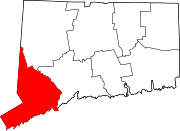Greenfield Hill, Connecticut: Difference between revisions
No edit summary |
Blackwelma01 (talk | contribs) No edit summary |
||
| Line 1: | Line 1: | ||
{{Refimprove|date=July 2011}} |
{{Refimprove|date=July 2011}} |
||
'''Greenfield Hill''' is |
'''Greenfield Hill''' is an affluent historic neighborhood of [[Fairfield, Connecticut]] roughly bounded by the Merritt Parkway (north), Burr Street (east), and the Southport and Westport borders form the southern/western bounderies. |
||
<!-- Image with unknown copyright status removed: [[Image:Greenfield.gif|frame|right]] -->Locally, Greenfield Hill is known for its Dogwood Festival, which celebrates a [[Cornus florida|variety of tree]] that abounds in the neighborhood. The most famous and perhaps the most picturesque landmark is the Greenfield Hill Congregational Church, which presides over a classic New England [[village green|green]]. [[Timothy Dwight IV]], best known as a president of [[Yale University]] (and the namesake of [[Timothy Dwight College|one of its residential colleges]]) was pastor of Greenfield Hill Congregational Church for many years.<ref>[http://web.me.com/greenfieldhillchurch/Site/GHCC_History.html GHCC History], Greenfield Hill Congregational Church website</ref> According to local lore, he was hired by Yale to thwart plans for a rival educational institution in Fairfield.{{Citation needed|date=February 2010 |
<!-- Image with unknown copyright status removed: [[Image:Greenfield.gif|frame|right]] -->Locally, Greenfield Hill is known for its Dogwood Festival, which celebrates a [[Cornus florida|variety of tree]] that abounds in the neighborhood. The most famous and perhaps the most picturesque landmark is the Greenfield Hill Congregational Church, which presides over a classic New England [[village green|green]]. [[Timothy Dwight IV]], best known as a president of [[Yale University]] (and the namesake of [[Timothy Dwight College|one of its residential colleges]]) was pastor of Greenfield Hill Congregational Church for many years.<ref>[http://web.me.com/greenfieldhillchurch/Site/GHCC_History.html GHCC History], Greenfield Hill Congregational Church website</ref> According to local lore, he was hired by Yale to thwart plans for a rival educational institution in Fairfield.{{Citation needed|date=February 2010} |
||
Besides Dwight, famous residents of Greenfield Hill have included [[Robert Penn Warren]], the author of ''All the King's Men'', composer and conductor [[Leonard Bernstein]] and [[John Hershey]], the author of "A Bell for Adano". Several officers of the [[AIG Financial Products]] unit live in Greenfield Hill and their homes were scenes of protest at the time of a scandal concerning the payment of $165 million in bonuses to employees of that unit.<ref>http://www.seattlepi.com/business/article/Activists-vent-at-AIG-executives-1302788.php</ref> |
Besides Dwight, famous residents of Greenfield Hill have included [[Robert Penn Warren]], the author of ''All the King's Men'', composer and conductor [[Leonard Bernstein]] and [[John Hershey]], the author of "A Bell for Adano". Several officers of the [[AIG Financial Products]] unit live in Greenfield Hill and their homes were scenes of protest at the time of a scandal concerning the payment of $165 million in bonuses to employees of that unit.<ref>http://www.seattlepi.com/business/article/Activists-vent-at-AIG-executives-1302788.php</ref> |
||
With its 2-acre minimum zoning and dense tree growth, Greenfield Hill is considered by many as a pleasant rural alternative to Connecticut's dense suburban design. Along with Southport, Greenfield Hill is considered one of the wealthiest districts of Fairfield, as well as Connecticut as a whole <ref>[http://www.nytimes.com/2003/06/22/realestate/if-you-re-thinking-living-greenfield-hill-fairfield-privacy-convenience-dogwoods.html] |
|||
The [[Greenfield Hill Historic District]] is listed on the [[National Register of Historic Places]] (NRHP). The district, along with [[Southport Historic District (Fairfield, Connecticut)|Southport Historic District]] and [[Fairfield Historic District (Fairfield, Connecticut)|Fairfield Historic District]] is somewhat governed{{Clarify|date=February 2010}} by Fairfield's Historic District Commission. |
The [[Greenfield Hill Historic District]] is listed on the [[National Register of Historic Places]] (NRHP). The district, along with [[Southport Historic District (Fairfield, Connecticut)|Southport Historic District]] and [[Fairfield Historic District (Fairfield, Connecticut)|Fairfield Historic District]] is somewhat governed{{Clarify|date=February 2010}} by Fairfield's Historic District Commission. |
||
Revision as of 21:16, 11 April 2014
This article needs additional citations for verification. (July 2011) |
Greenfield Hill is an affluent historic neighborhood of Fairfield, Connecticut roughly bounded by the Merritt Parkway (north), Burr Street (east), and the Southport and Westport borders form the southern/western bounderies.
Locally, Greenfield Hill is known for its Dogwood Festival, which celebrates a variety of tree that abounds in the neighborhood. The most famous and perhaps the most picturesque landmark is the Greenfield Hill Congregational Church, which presides over a classic New England green. Timothy Dwight IV, best known as a president of Yale University (and the namesake of one of its residential colleges) was pastor of Greenfield Hill Congregational Church for many years.[1] According to local lore, he was hired by Yale to thwart plans for a rival educational institution in Fairfield.{{Citation needed|date=February 2010}
Besides Dwight, famous residents of Greenfield Hill have included Robert Penn Warren, the author of All the King's Men, composer and conductor Leonard Bernstein and John Hershey, the author of "A Bell for Adano". Several officers of the AIG Financial Products unit live in Greenfield Hill and their homes were scenes of protest at the time of a scandal concerning the payment of $165 million in bonuses to employees of that unit.[2]
With its 2-acre minimum zoning and dense tree growth, Greenfield Hill is considered by many as a pleasant rural alternative to Connecticut's dense suburban design. Along with Southport, Greenfield Hill is considered one of the wealthiest districts of Fairfield, as well as Connecticut as a whole <ref>[1]
The Greenfield Hill Historic District is listed on the National Register of Historic Places (NRHP). The district, along with Southport Historic District and Fairfield Historic District is somewhat governed[clarification needed] by Fairfield's Historic District Commission.
There is a Greenfield Hill Grange No. 133 which is separately NRHP-listed.[citation needed]
References
- ^ GHCC History, Greenfield Hill Congregational Church website
- ^ http://www.seattlepi.com/business/article/Activists-vent-at-AIG-executives-1302788.php

